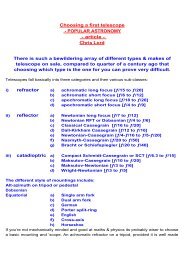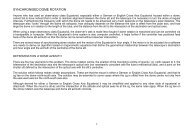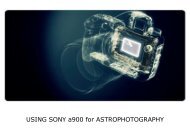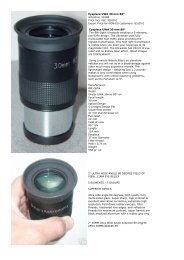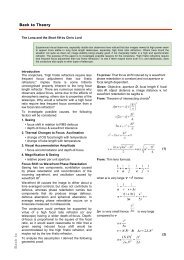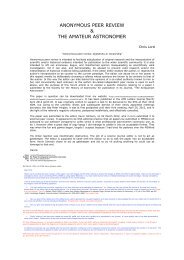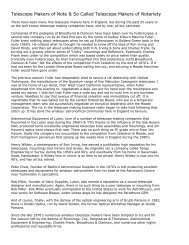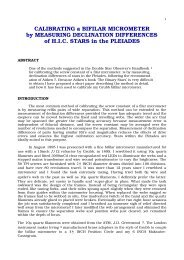Evolution of the Astronomical Eyepiece - Brayebrook Observatory
Evolution of the Astronomical Eyepiece - Brayebrook Observatory
Evolution of the Astronomical Eyepiece - Brayebrook Observatory
Create successful ePaper yourself
Turn your PDF publications into a flip-book with our unique Google optimized e-Paper software.
CARE & MAINTENANCE <strong>of</strong><br />
EYEPIECES (Cont.):<br />
EVOLUTION <strong>of</strong> <strong>the</strong> ASTRONOMICAL EYEPIECE<br />
dam p environm en t for any leng th<br />
<strong>of</strong> time, lead sulphi de ca n form on<br />
th e s urface wh ich is a lmost impossible<br />
to rem ove. Cert ain bari um<br />
c rown gla sse s used i n som e wide<br />
ang le m ilit ary eyepieces w il l dev itrify,<br />
ma king <strong>the</strong> l en s mi lky. Also if<br />
d ropp ed, or subjec ted to a vi olent<br />
t e m p e r a t u re chan ge, c em en ted<br />
lenses can separate, r esu lti ng i n<br />
Newto n’s ri ngs appe arin g. A<br />
cemen ted e lement eyepiece shou ld<br />
not b e used f or sola r pro j e c t i o n ,<br />
and <strong>the</strong> f ield stop mu st be bigger<br />
than th e p rime f ocal im age, or <strong>the</strong><br />
b a r rel wi ll ov erh e a t .<br />
THE EYEPIECE & THE EYE<br />
The eye is chromatical ly underc o r-<br />
rected by approximate ly 0.25 d iopt<br />
res at both red an d v iolet wa velengths,<br />
an d in ge ne ral, spheric all y<br />
u n d e rc o r rect ed for pupil lia ry apert<br />
u re s l es s than 3m m. How ever,<br />
sp he rical co rrection a t wide r eye<br />
pu pils ra ng es from several dioptre s<br />
u n d e rc o r r ecti on to severa l di optre s<br />
o v e rc o r r e c t i o n .<br />
The ey e perf o rms bett er when its<br />
i n h e r en t a ch ro mat is m is c ompensat<br />
ed by a chroma tic overc o r re c t i o n<br />
<strong>of</strong> th e eyepiece -objective combi nat<br />
ion. S uch co mpen satio n, term e d<br />
h y p o c h r oma tism, i s commo nly feat<br />
u red in th e design <strong>of</strong> h igh qu ality<br />
bi nocul ars an d spotti ng telescopes.<br />
When <strong>the</strong> bl ur siz e <strong>of</strong> a n object is<br />
less than 1’ arc <strong>the</strong> eye interpre t s<br />
<strong>the</strong> image as a poi nt. T his ab erra -<br />
tion to lerance in creases to mo re<br />
than 5’ a rc <strong>of</strong> f axis, a nd hence t he<br />
extra -ax ial a berrati ons a t <strong>the</strong> e dge<br />
<strong>of</strong> a wide angle eye piece are m uch<br />
less cri tical than those on a xis.<br />
When <strong>the</strong> brilliance <strong>of</strong> <strong>the</strong> image cau ses<br />
<strong>the</strong> pupil to contract to its smallest size<br />
(about 1.5mm), effectively <strong>the</strong> system<br />
48<br />
focal ratio is reduced to:<br />
ef / no. = Fe /Ep<br />
For exa mple, when o bserving t he Full<br />
Moon at l ow power with a 45mm eyepiece,<br />
<strong>the</strong> relati ve aperture will be<br />
reduced to approximately f/30, at<br />
w hich al most any eyepiece type will<br />
p e rf o rm w ell.<br />
Correction is needed in <strong>the</strong> presence <strong>of</strong><br />
astigmatism, especially when <strong>the</strong> exit<br />
pupil and <strong>the</strong> eye pupil both exceed<br />
3mm. Special stigmatic lenses can be<br />
fitted to eyepieces with <strong>the</strong> required<br />
cylinder com pensa tion . Alt ern a t i v e l y<br />
wher e <strong>the</strong> eye point distance permits,<br />
spectacles may be worn, though unless<br />
astigmatism is sever e (exceeds 2 dioptres),<br />
it is better to observe without<br />
<strong>the</strong>m. It is not necessary to wear reading<br />
or distance spectacles intended to<br />
compensate myopia, hyper metropia or<br />
presbyopia because all <strong>the</strong>se sight deficiencies<br />
can be corrected by refocusing.<br />
In general, spectacles interfer e with <strong>the</strong><br />
observer’s access to <strong>the</strong> eye point and<br />
restrict <strong>the</strong> apparent field. Also reflections<br />
<strong>of</strong>f <strong>the</strong> lens can reduce image contrast<br />
and prove very distracting. In any<br />
case visual astigmatism will not reduce<br />
image sharpness or contrast when less<br />
than 2 dioptres. At high powers where<br />
<strong>the</strong> exit pupil is less than 1mm, even<br />
severe visual astigmatism has a negligible<br />
effect on <strong>the</strong> image.<br />
In <strong>the</strong> author’s estimation a lot <strong>of</strong> nonsense<br />
has been written about <strong>the</strong> pros<br />
and cons <strong>of</strong> spectacle wearers keeping<br />
<strong>the</strong>ir spectacles on when observing. The<br />
most common reason for failing to see<br />
what a more experienced observer sees<br />
is lack <strong>of</strong> training, not acuity. It is sadly<br />
a truism, that some are much more<br />
adept than o<strong>the</strong>rs at acquiring <strong>the</strong> skills<br />
<strong>of</strong> a good observer, and no am oun t <strong>of</strong><br />
fi ddl ing aroun d with eyepieces an d<br />
f ilter s i s goin g to al ter tha t o ne iota.



